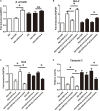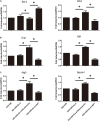High Glucose Attenuates Cardioprotective Effects of Glucagon-Like Peptide-1 Through Induction of Mitochondria Dysfunction via Inhibition of β-Arrestin-Signaling
- PMID: 34054568
- PMCID: PMC8155506
- DOI: 10.3389/fphys.2021.648399
High Glucose Attenuates Cardioprotective Effects of Glucagon-Like Peptide-1 Through Induction of Mitochondria Dysfunction via Inhibition of β-Arrestin-Signaling
Abstract
An increased vulnerability has been detected after ischemia/reperfusion injury in cardiomyocytes in diabetic patients. Glucagon-like peptide-1 (GLP-1) has been proven to have a notable cardioprotective effect in cardiomyocytes. However, in diabetic patients, the cardioprotective effects of GLP-1 are compromised, which is called GLP-1 resistance. β-arrestin is one of the two main downstream effectors of GLP-1 and β-arrestin signaling pathway exerts cardioprotective effects upon activation of GLP-1R. Our hypothesis is that the increased vulnerability of cardiomyocytes in diabetic patients is partly due to disruption of the β-arrestin signaling pathway. To test this, we analyzed cardiomyocyte viability and survival in high glucose and normal glucose condition after hypoxia/reoxygenation injury in vitro, additional GLP-1 was used to determine whether β-arrestin signaling pathway was involved. We also investigated the role of mitochondrial dysfunction in GLP-1 resistance. Our results showed that cardioprotective effects of GLP-1 were reduced in high glucose cultured H9C2 cells compared to normal glucose cultured H9C2, verifying the existence of GLP-1 resistance in high glucose cultured H9C2 cells. Further study suggested that β-arrestin plays a key role in GLP-1 resistance: β-arrestin expression is notably downregulated in high glucose condition and cardioprotective effects of GLP-1 can be diminished by downregulation of β-arrestin in normal glucose condition while upregulation of β-arrestin can restore cardioprotective effects of GLP-1 in high glucose condition. Then we explore how β-arrestin affects the cardioprotective effects of GLP-1 and found that β-arrestin exerts cardioprotective effects by improving mitochondria quality control via the PI3K/Akt signaling pathway. Thus, our study found out a new mechanism of GLP-1 resistance of cardiomyocytes in high glucose conditions that impaired β-arrestin expression, caused mitochondria dysfunction and eventually cell death. Our study provided a new perspective in treating myocardial ischemia/reperfusion injury in diabetic patients.
Keywords: GLP-1; PI3K/Akt; diabetic cardiomyocyte; mitochondria dysfunction; β-arrestin.
Copyright © 2021 Pan, Li and Gao.
Conflict of interest statement
The authors declare that the research was conducted in the absence of any commercial or financial relationships that could be construed as a potential conflict of interest.
Figures





Similar articles
-
Essential Role Of High Glucose-Induced Overexpression Of PKCβ And PKCδ In GLP-1 Resistance In Rodent Cardiomyocytes.Diabetes Metab Syndr Obes. 2019 Nov 4;12:2289-2302. doi: 10.2147/DMSO.S215789. eCollection 2019. Diabetes Metab Syndr Obes. 2019. PMID: 31807042 Free PMC article.
-
Glucagon-like peptide-1 attenuates endoplasmic reticulum stress-induced apoptosis in H9c2 cardiomyocytes during hypoxia/reoxygenation through the GLP-1R/PI3K/Akt pathways.Naunyn Schmiedebergs Arch Pharmacol. 2019 Jun;392(6):715-722. doi: 10.1007/s00210-019-01625-2. Epub 2019 Feb 14. Naunyn Schmiedebergs Arch Pharmacol. 2019. PMID: 30762075
-
Glucagon-like peptide-1 protects cardiomyocytes from advanced oxidation protein product-induced apoptosis via the PI3K/Akt/Bad signaling pathway.Mol Med Rep. 2016 Feb;13(2):1593-601. doi: 10.3892/mmr.2015.4724. Epub 2015 Dec 28. Mol Med Rep. 2016. PMID: 26717963 Free PMC article.
-
Multifaceted Roles of GLP-1 and Its Analogs: A Review on Molecular Mechanisms with a Cardiotherapeutic Perspective.Pharmaceuticals (Basel). 2023 Jun 3;16(6):836. doi: 10.3390/ph16060836. Pharmaceuticals (Basel). 2023. PMID: 37375783 Free PMC article. Review.
-
Glucagon-Like Peptide-1: A Promising Agent for Cardioprotection During Myocardial Ischemia.JACC Basic Transl Sci. 2016 Jun 27;1(4):267-276. doi: 10.1016/j.jacbts.2016.03.011. eCollection 2016 Jun. JACC Basic Transl Sci. 2016. PMID: 30167515 Free PMC article. Review.
Cited by
-
Syringaldehyde Alleviates Cardiac Hypertrophy Induced by Hyperglycemia in H9c2 Cells Through GLP-1 Receptor Signals.Pharmaceuticals (Basel). 2025 Jan 16;18(1):110. doi: 10.3390/ph18010110. Pharmaceuticals (Basel). 2025. PMID: 39861172 Free PMC article.
-
β-arrestin1 protects intestinal tight junction through promoting mitofusin 2 transcription to drive parkin-dependent mitophagy in colitis.Gastroenterol Rep (Oxf). 2024 Sep 6;12:goae084. doi: 10.1093/gastro/goae084. eCollection 2024. Gastroenterol Rep (Oxf). 2024. PMID: 39246845 Free PMC article.
References
-
- Ceriello A., Esposito K., Testa R., Bonfigli A. R., Marra M., Giugliano D. (2011). The possible protective role of glucagon-like peptide 1 on endothelium during the meal and evidence for an “endothelial resistance” to glucagon-like peptide 1 in diabetes. Diabetes Care 34 697–702. 10.2337/dc10-1949 - DOI - PMC - PubMed
LinkOut - more resources
Full Text Sources
Other Literature Sources

